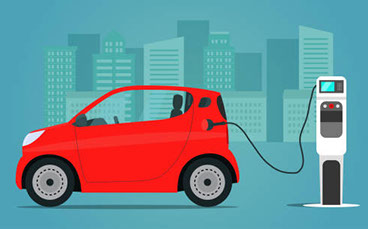ELECTRIFICATION
Photography: Wayne Michaud
Green Driving America has advocated for beneficial green/smart driving behaviors such as "slow down", "accelerate and brake smoothly", "avoid unnecessary idling", etc. But as important as adopting these behaviors are, we also place an emphasis on WHAT you drive, and how, more than ever, the evolving technology of transportation today and into the future means cleaner and clean vehicles.
 Traditional internal combustion engine (ICE) vehicles have dominated transportation for around 120 years. But they are now finite, thanks to global, federal and state governmental entities taking strong measures to deal with transportation's role in the increasing threat of climate change. And now the auto industry at large is joining in the evolution towards alternative fuel vehicles. Vehicle electrification is recognized as the clear leader in the goal to eventually eliminate gas vehicles from our roads.
Traditional internal combustion engine (ICE) vehicles have dominated transportation for around 120 years. But they are now finite, thanks to global, federal and state governmental entities taking strong measures to deal with transportation's role in the increasing threat of climate change. And now the auto industry at large is joining in the evolution towards alternative fuel vehicles. Vehicle electrification is recognized as the clear leader in the goal to eventually eliminate gas vehicles from our roads.
Vehicle electrification (after a brief rise in the early part of the 20th century) is an evolving technology that began in mass production form with hybridization in the beginning of the 21st century. On the way to pure forms of electrification, these transitional steps have included milder, lower-cost stop-start systems and more robust plug-in hybrids (PHEV). A much smaller segment of the alternative fuel market includes hydrogen fuel cell vehicles.
While electrification of the vehicle fleet will eventually include all types and classes by the mid part of this century, for now most offerings are passenger cars. Several manufacturers of EV pickup trucks are on the threshold of joining in. And Municipal and school buses are making inroads to electrification as well. Lagging behind and still largely in the developmental stage are medium-duty trucks to heavy-duty semis.
Under the U.S. Biden administration, the Inflation Reduction Act of 2022 was signed into law. According to the Electrification Coalition, it "is perhaps the most significant legislation to accelerate transportation electrification in U.S. history". It will enhance the continued growth of electric vehicles, along with the deployment of many thousands of new public charging stations.
WHY GO ELECTRIC?
ENVIRONMENT & EFFICIENCY: Traditional internal combustion engine (ICE) vehicles are bad for the environment. And not only that, they are extremely energy inefficient. On average, only about one-fifth of such a vehicle’s fuel source—gasoline—goes toward propelling it. The rest is expended as heat and friction. All together, this wasteful melange of transportation GHG emissions is a big contributor to climate change. On the other hand, according to Fueleconomy.gov and Yale Climate Connections, electric vehicles use half the energy of gas-powered vehicles, with a corresponding reduction in GHG emissions.
COST: The retail price of today’s new EVs can be significantly higher than their gasoline-powered counterparts. This is especially apparent where virtually no EVs are being offered as base model subcompacts. However, when factoring in the plethora of federal tax credits and state and electric utility company cash incentives/rebates, it is possible to score a good deal on an EV. Even new EVs with range in excess of 200 miles are becoming more affordable, especially with these federal and state incentives/rebates. Plus, an increasing number of states are now offering incentives for used EVs (state budgets can limit incentives to a portion of a year), including but not limited to: Vermont's MileageSmart program (up to $5,000 to income-qualified buyers), Illinois' Electric Vehicle Rebate ($4,000), Xcel Energy of Colorado program (up to $3,000 to income-qualified buyers), Connecticut CHEAPR program (up to $4,000 to income-qualified buyers), and Washington EV Instant Rebate Program ($2,500 and $9,000 off for low-income residents, starting Aug. 2024); California's Driving Clean Assistance Program for new and used EV/PHEV will launch in latter 2024. Another EV cost advantage over ICE vehicles is their approximately 60% lower fuel costs and about one-half the maintenance costs. According to MIT, this already makes them less expensive over their lifetimes.
ARE EVs FOR EVERYONE?
Electric passenger vehicles, while being offered in an increasing number of models from 2021 on, are still not for everyone just yet, but are suiting the needs of more and more drivers. Longer commuting distances can present challenges for some, especially in range-cutting colder climates (though this can be mitigated for EVs equipped with heated seats/steering wheel and largely alleviated with the availability of workplace charging). The miles that newer EVs can travel between recharging is increasing every year, along with a growing charging station infrastructure that many states are committed to.
The website Electric for All is an excellent guide on PHEVs and EVs.
Just plug in your zipcode for a:
• complete comparison of makes and models, and their cost and range
• listing of incentives/rebates on new and used clean/cleaner vehicles ranging from the EV federal tax credit to state governmental incentives and utility company incentives, plus various other incentives, discounts and perks
• listing of all dealers in the area selling EVs
• listing of EV charging and hydrogen fueling stations
EV PERFORMANCE: EVs ride and handle quite similarly to their ICE counterparts. But when it comes to acceleration, EVs are no slouches due to their built-in torque and one-speed gearing that offers quick off the line performance.
 USED EVs: these vehicles are usually low to mid mileage vehicles from model years 2011 and newer. While they typically only offer a range of 75-100 miles, they can be reasonably priced due to significant depreciation, ranging from as little as $4,000 for a 2011-2012 model to $7,000-$12,000 for a 2014-2016 model. Used EVs have typically one-half of the repair and maintenance costs (much fewer moving parts, no gas, no oil changes, longer lasting brakes, etc.), and odometer miles of internal combustion engine vehicles. Most auto manufacturers warrant the electric vehicle battery (aka traction battery) for eight years/100,000 miles. These batteries typically last much longer. Popular Mechanics: Used EVs are getting cheaper. Should you buy one? (May 2024)
USED EVs: these vehicles are usually low to mid mileage vehicles from model years 2011 and newer. While they typically only offer a range of 75-100 miles, they can be reasonably priced due to significant depreciation, ranging from as little as $4,000 for a 2011-2012 model to $7,000-$12,000 for a 2014-2016 model. Used EVs have typically one-half of the repair and maintenance costs (much fewer moving parts, no gas, no oil changes, longer lasting brakes, etc.), and odometer miles of internal combustion engine vehicles. Most auto manufacturers warrant the electric vehicle battery (aka traction battery) for eight years/100,000 miles. These batteries typically last much longer. Popular Mechanics: Used EVs are getting cheaper. Should you buy one? (May 2024)
INSTEAD OF DRIVING AN EV, CONSIDER RIDING AN EV
Green Driving America encourages the idea of driving less or not at all. For some people with short commutes or who work from home, public transit and ride sharing are options. So is walking, bike riding or riding an electric bike. Like standard bikes, e-bikes are available in a range of configurations: mountain bikes, cruiser bikes, road/commuter bikes, fat tire bikes and folding bikes. E-bikes offer a wide range of pricing from budget models ($500-1,000), mid range ($1,200-2,500), and premium ($5,000-10,000). E-BIKE GUIDE
with short commutes or who work from home, public transit and ride sharing are options. So is walking, bike riding or riding an electric bike. Like standard bikes, e-bikes are available in a range of configurations: mountain bikes, cruiser bikes, road/commuter bikes, fat tire bikes and folding bikes. E-bikes offer a wide range of pricing from budget models ($500-1,000), mid range ($1,200-2,500), and premium ($5,000-10,000). E-BIKE GUIDE
And of course, electric motorcycles offer emissions-free performance and virtually none of the noise.
EMPLOYING GREEN DRIVING BEHAVIORS: FOR EVs TOO?
While EV driving is much closer to guilt-free than ICE vehicles in emissions and air quality impact, nonetheless, virtually every tip on the Smart Driving TIPS page is indeed applicable to driving an EV! Tips ranging from watching speed, accelerating and braking smoothly, A/C setting, tire wear, etc., equate to the cost savings of extending the range of an EV such as by using less kilowatt-hours (kWh) and maximizing regenerative braking. And of course being a safer driver.
OTHER EV INFORMATION SOURCES

In addition to the Electric for All guide...
• Plug In America has a complete national listing of EV Clubs by location and by vehicle model.
• Electric Vehicle Association: getting connected to a network of EV advocates
• InsideEVs: from their About Us page: "To inform and empower a new generation of drivers about the high-tech, zero-emission
transformation of the car industry."
• California Air Resources Board - DriveClean: Electric Car Charging Overview
• California Air Resources Board: Hydrogen Fuel Cell Electric Cars
• Geotab: To what degree does temperature impact EV range?
• Recurrent: Winter Range for Popular EV Models
• Clean Technica: More Electric Trucks Coming To US, But China Still Leads
• EV Magazine: Top 10: Electric Pickup Trucks
• U.S. DOE Alternative Fuels Data Center: Electric Vehicle Research and Development
• Union of Concerned Scientists: Electric Vehicles are Cleaner
GREEN DRIVING AMERICA LINKS TO ELECTRIC VEHICLE ENVIRONMENTAL IMPACTS:
• BATTERY RECYCLING
• BATTERY REPURPOSING
• BATTERY ALTERNATIVES
• EFFECT ON GRID
• MINING FOR METALS
• EV vs HYBRID vs GAS
• EV SOURCES OF POWER
• EV vs GAS VEHICLE SAFETY & FIRES
